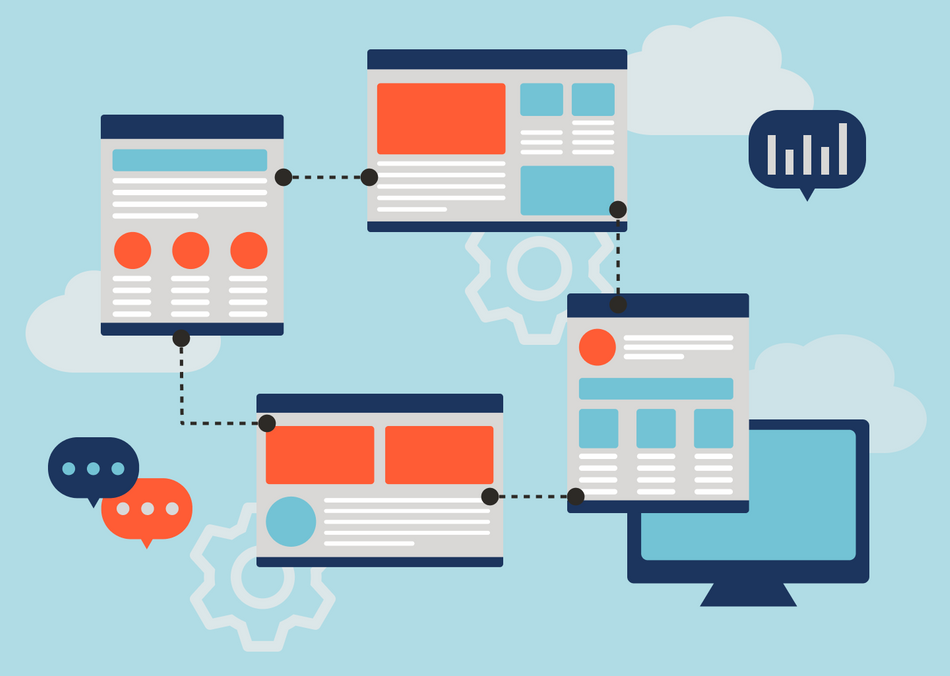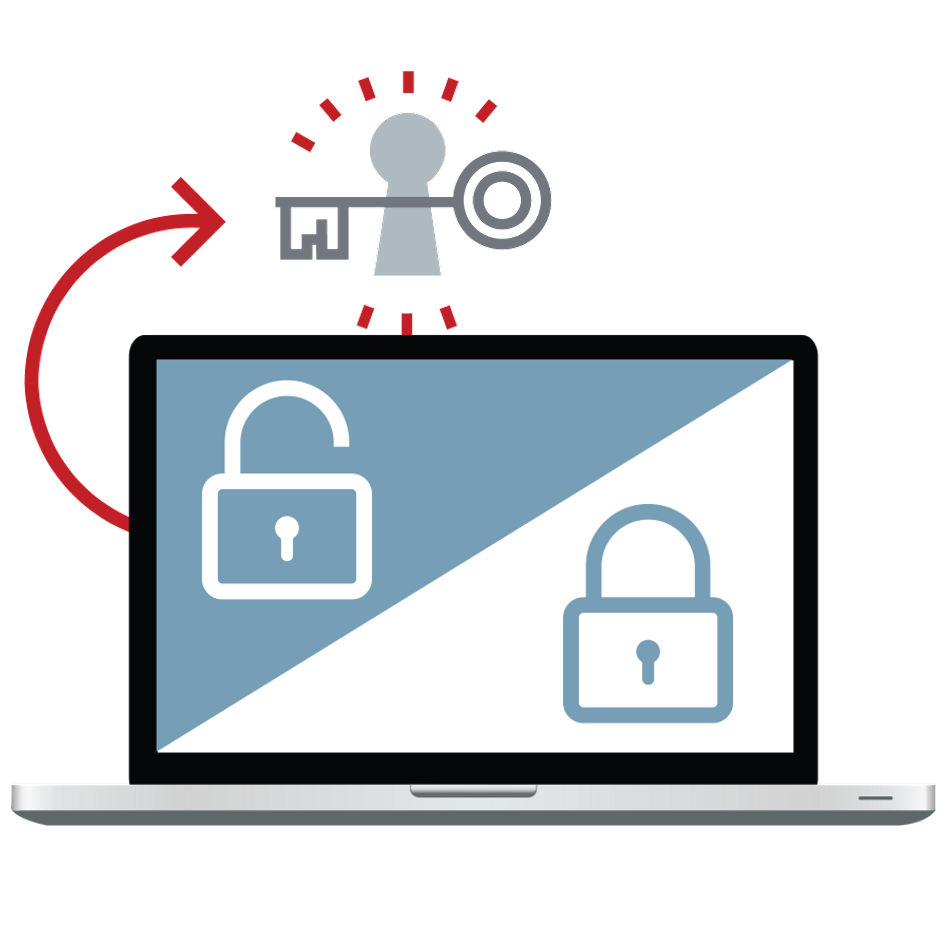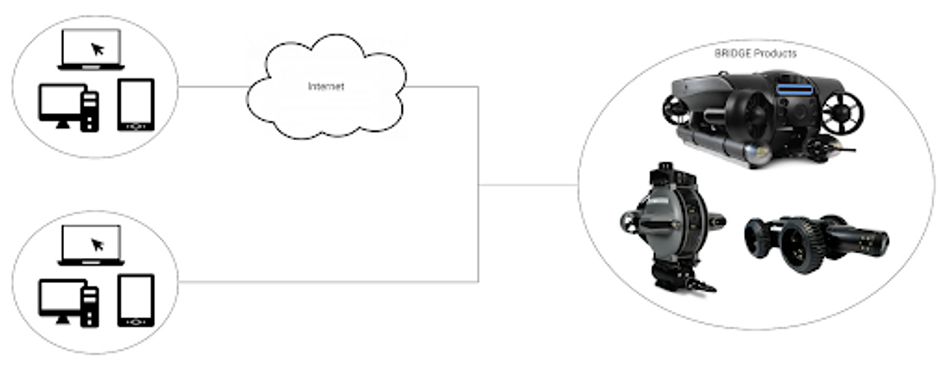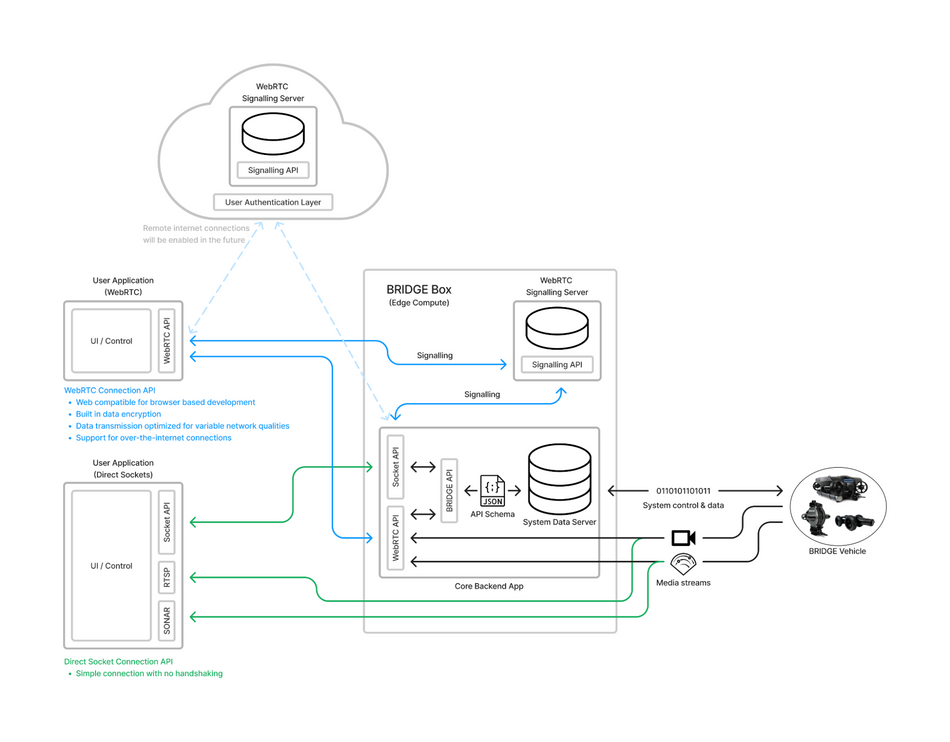What Types of Software Are Commonly Used For ROVs?
Learn about the software used by ROV companies. See how Deep Trekker uses its software to benefit the users of its products.

Deep Trekker ROV controller and software interface.
This article was first published on
www.deeptrekker.comUnderstanding Software Types: Proprietary, Open Source, and API
Software plays an important role in our lives, powering the applications and systems we use in our everyday lives. It can be categorized into different types based on characteristics, licensing models, availability of source code, and usage restrictions. Three common types of software are:
- Open-source software
- Software with an API (Application Programming Interface)
- Proprietary software
The choice of software type depends on factors such as the intended purpose, licensing requirements, and the level of control and customization desired by the users or developers.
Let’s take a deeper dive into the three main types of software.
Open Source Software
Open Source Software (OSS) is all about accessibility, and is made available to the public with its source code, allowing anyone to view, modify, and distribute the software freely. The underlying code of the software is openly accessible to everyone, promoting collaboration, transparency, and community-driven development.
Some popular examples of Open Source software include:
- Operating Systems: Linux (e.g., Ubuntu, Fedora)
- Web Browsers: Mozilla Firefox, Chromium
- Media Player: VLC, MPV
- Office Suites: LibreOffice, Apache OpenOffice
- Content Management Systems: WordPress, Drupal
- Web Servers: Apache HTTP Server, Nginx
- Programming Languages: Python, Java, Ruby
- Development Tools: Git, Visual Studio Code
- Design and Photo Editing: Scribus, GIMP
- Database Systems: MySQL, PostgreSQL

The Benefits of Open Source Software
The pros and cons of open source software can vary depending on the specific software and use case.
One of the main benefits of OSS is, of course, the cost. Generally available for free, with no copyright or licencing requirements, it’s a great fit for individuals, small businesses, educational institutions, and organizations with limited budgets. This makes it a very cost-effective solution, allowing users to allocate their resources more efficiently.
Flexibility and customization are also great benefits of open source software, providing users with the freedom to modify and adapt the software according to their specific needs. Open access to the source code allows developers to customize the software's features, functionality, and even appearance, offering a level of flexibility that is not typically possible with proprietary software.
Open source software also thrives on collaboration and benefits from a vast community of developers worldwide. This community actively contributes to the software's development, offering bug fixes, feature enhancements, and improvements. The collective effort of this community leads to rapid innovation and continuous updates. Users also benefit from the shared knowledge and support available through community forums and resources, and the collaboration of developers around the world can lead to innovations that help evolve the software on an ongoing basis.
The Disadvantages of Open Source Software
The main disadvantage of open source software is ultimately due to one of its main benefits - the amount of people using and changing the software. Because it is open to modification, there is no guarantee that it will work as intended, and users may encounter problems or unforeseen bugs. Additionally, no one is required to fix any bugs that may be present, so there is no assurance that open source software will be a smooth bug free experience.
Support can also be an issue with open source software, since it typically relies on community support rather than dedicated customer support provided by proprietary software. The level and quality of support can vary. Users may need to rely on community forums, documentation, and online resources to find answers to their questions or solutions to their issues. This can be time-consuming and may not offer the same level of immediate assistance as commercial support options users receive through proprietary software.
Compatibility and limited functionality and features are also factors to consider when evaluating open source software. Unlike proprietary software, OSS does not benefit from abundant resources and dedicated development teams focused on delivering specific functionalities or user-friendly interfaces. This means that open source software is often not as advanced as it could be, and generally not as polished as proprietary software, lacking the same level of sophistication or refinement.
API Software
Application Programming Interface (API) software is essentially a bridge that connects different types of software and apps, facilitating communication between them using a series of rules.
It refers to a set of defined rules and protocols that enable different software applications to communicate and interact with each other. It is an integration tool that acts as a bridge that allows software components, services, or platforms to exchange data and functionality in a standardized and controlled manner.
Rideshare, cloud services, universal logins, or the Internet of Things (IoT) - that enables communication with smart devices, such as changing your house thermostat from your phone - are examples that use API software to communicate with other applications.
Some more common examples of API software include:
- Social Media: Facebook, Twitter, and Instagram enable developers to integrate social media functionalities into their applications, such as posting updates, retrieving user data, logging into websites, or interacting with social networks.
- Payment Gateways: PayPal, Stripe, or Braintree offer APIs that allow developers to integrate secure payment processing into their applications, enabling online transactions and handling of financial data.
- Geolocation and Maps: Google Maps, Mapbox, or OpenStreetMap provide APIs that offer mapping, geocoding, and routing services, enabling developers to embed maps, locate addresses, and calculate directions in their applications.
The worldwide API management market size is projected to grow from $4.5 billion USD in 2022 to over $13 billion by 2027, according to global forecast reports, which clearly shows the demand and importance of APIs in the digital economy.

The Benefits of API Software
The future of APIs continues to grow and show incredible promise, and with new innovations such as no-code API development, accessibility and the ability to create and customize APIs has never been easier.
Individuals and businesses are using more and more applications every day, and the ability to integrate the many software platforms we use comes with a range of benefits, including:
- Increased interoperability
- Improved efficiency
- Better user experience
- Increased flexibility
- New revenue streams
Enabling different software systems to communicate with each other, regardless of their programming language or platform, enhances the interoperability between systems, allowing for the exchange of data and functionality. This seamless integration and interoperability between diverse software systems allows applications to work together efficiently.
API driven infrastructures promote efficiency by enabling developers to reuse code and functionality from existing software systems. These reusable modules save valuable time and reduce the amount of code that needs to be written from scratch, freeing up bandwidth for developers, enabling them to leverage existing capabilities and reduce development efforts.
The ability to develop and integrate 3rd party applications with existing software also increases their functionality, which improves the user experience by streamlining processes, automating workflows, and improving workplace collaboration. Without this connectivity, information silos are created that compromise productivity and performance.
One of the greatest benefits of APIs is the ability to adapt to changes through data migration and flexibility of services. APIs enable developers to choose the best programming languages and frameworks for their needs, acting as a solution to create different experiences for users, and letting protocols, functions, and commands be adapted according to specific demands.
The flexibility of APIs also allows companies to make connections with new business partners, offer new services to their existing market, and access new markets that can generate substantial returns and drive digital transformation.
APIs can also allow companies to create new revenue streams in a variety of ways, such as:
- Partner integrations: For example, an an e-commerce platform may provide APIs to enable integration with logistics providers, payment gateways, or inventory management systems, generating revenue through partnership agreements or revenue-sharing models.
- Marketplace Platforms: Companies can create marketplaces, such as app stores, where they can host 3rd party applications or services and charge developers a fee forthe listing. Apple App Store and Google Play Store are popular examples of this.
- Data Monetization: Many companies offer APIs for free initially, to forge relationships with potential business partners, but they can also be used to grant and sell access to valuable digital assets. Examples include financial data providers, weather data providers, and social media analytics platforms.
API software offers considerable advantages in terms of interoperability, extensibility, and integration capabilities. However, it's important to consider the specific requirements, security implications, and potential dependencies when designing and utilizing APIs in software development projects.

The Disadvantages of API Software
Although APIs are excellent integration tools, there are factors to consider to help ensure successful integration and utilization of APIs. Challenges can vary depending on the specific API, its implementation, and the nature of the integration, so it’s important to be mindful of these challenges and develop mitigation strategies if needed.
Some challenges included:
- Dependency
- Compatibility
- Security
- Complexity
- Reliability
APIs rely on external software or services for functionality, creating dependencies that are outside of the control of the company that owns the software system. If the API provider experiences downtime, makes changes to the API, or discontinues the service, it can disrupt the functionality of the dependent applications. Also, when using third-party APIs, developers have limited control over the functionality, performance, and future development of the API, so it is essential to carefully evaluate the stability and reliability of API providers and consider backup options or contingency plans.
Compatibility can also be an issue, since APIs can receive changes and updates, and new versions can potentially introduce changes that “break” the integrated software, requiring modifications in the code of applications using the API. Managing API versioning and ensuring backward compatibility can be challenging, especially when dealing with multiple versions or multiple APIs from different providers.
Additionally, APIs can be potential targets for security breaches or unauthorized access. Inadequate authentication, insufficient access controls, or vulnerabilities in the API implementation can expose sensitive data or allow malicious actions. Implementing robust security measures, such as secure authentication, encryption, and access controls, is critical to mitigating these security risks.
The complexity of APIs can also pose a significant challenge, and can require a substantial amount of development effort to implement and maintain. Working with APIs generally requires developers to understand the API documentation, authentication mechanisms, request/response formats, and error handling. This means that developers need to invest time and effort in learning the specific APIs and their integration patterns, which can increase the complexity and learning curve of development.
Proprietary Software
Proprietary software is owned and developed by an individual, company, group, or organization. It grants exclusive rights to the software creator or owner, protected by copyright, patents, or other intellectual property (IP) rights, and distributed under specific licensing terms that restrict its use, modification, distribution, replication, and access to its source code.
Some popular examples of proprietary software include:
- Microsoft Office
- Adobe Creative Suite
- Console video games
- iTunes / Spotify
- Windows / macOS / ChromeOS
It's important to consider your specific requirements, budget, and long-term goals when deciding between proprietary software and other software types, such as open source software. Organizations and users should assess the benefits and challenges and select the software that best aligns with their needs and priorities.
The Benefits of Proprietary Software
Though open source software has been growing in popularity over the years, becoming a valid consideration for some companies, proprietary software offers several key benefits that has historically made it a preferred choice for many users and organizations.
For example:
- Stability
- Security
- Support
Proprietary software is robust and less prone to crashes or performance issues because it is subjected to thorough, rigorous testing, quality assurance processes, and performance optimization before release to ensure stability and performance. Because proprietary software is available through purchase, the software must be delivered in a stable and reliable state to maintain customer satisfaction and industry competitiveness. This means that proprietary software is typically shipped bug free, which is a crucial factor for companies that rely on the software to be functional for daily operations.
Security and compliance measures are also typically prioritized, with a focused investment in robust security protocols, regular security audits, and timely security updates and patches to address vulnerabilities. Proprietary software offers enhanced security features, data encryption, and access controls that are typically not found in open source software, ensuring the protection of sensitive information.
Also unlike open source software, the software owner is a clear point of contact for users of proprietary software for accountability and support. The software owners need to maintain their reputation and customer satisfaction associated with their product, so they are committed to addressing issues, providing technical assistance, and offering service level agreements (SLAs) for response times and problem resolution. Users can expect extensive support, including documentation, user forums, customer service, and regular updates, and rely on the software owners to provide ongoing maintenance, bug fixes, and feature enhancements.

The Disadvantages of Proprietary Software
Proprietary software, despite its many benefits, also has some disadvantages that users and organizations should consider.
Some of the key disadvantages of proprietary software include:
- Limited customization and transparency
- Cost
- Dependency on the software owner
- Lack of innovation
Restricted access to the source code prevents users from making changes or adding functionality independently, removing the ability to modify or customize the software to fit the users specific needs, which limits the software's adaptability to unique requirements. This also limits the software’s flexibility and transparency, as users cannot review or verify the software's internal workings, making it difficult to assess security measures, potential vulnerabilities, or hidden functionalities.
Licensing fees or subscription costs are one of the biggest dififerences of proprietary software compared to open source - which can be substantial, especially for commercial or enterprise-grade applications. This cost can be a crucial factor for organizations with limited budgets or for individual users seeking more affordable options. Additionally, proprietary software can also require additional costs for maintenance, upgrades, and technical support.
Dependency on the software owner introduces a level of risk to users of proprietary software. If the vendor goes out of business, discontinues support for the software, or abandons the product, users will be left with the challenge of finding alternatives, receiving necessary support, or ensuring the software's continued operation.
Also, when users become dependent on a specific vendor for ongoing support, updates, and compatibility, switching to alternative software or migrating data can be difficult, due to differences in file formats, APIs, or proprietary protocols. This “lock-in” can restrict users' freedom of choice and hinder the ability to transition to more suitable solutions.
Additionally, with proprietary software, the owner decides the direction of development, prioritizes features based on their business interests, and may not incorporate user suggestions or requests. This lack of influence can potentially restrict the alignment of the software with specific user needs and industry trends.
Open Source vs API vs Proprietary
In summary, Open source software is categorized by its publicly available source code that is generally free for anyone to use or modify, while proprietary software is distinguished by its closed source code and licensing restrictions. API, by comparison, represents a bridge, or software interface that allows communication between different software applications.
Improving Efficiency with Web-Based Architecture
Web-based architecture refers to the way technical pieces are laid out and orchestrated at a high level that leverage the capabilities of web technologies. Some of these technologies include browsers, HTTP protocols, and servers. By adopting a web-based architecture, organizations can improve efficiency in several ways, such as:
- Flexibility and convenience
- Cross-platform compatibility
- Integration with existing systems
Web-based applications can be accessed from any device with a web browser and an internet connection. This accessibility enables users to communicate with devices remotely, access information on the go, and collaborate with others in real-time. By eliminating the constraints of location and device dependency, web-based architecture improves efficiency and productivity.
Typically platform-independent, web-based applications can run on various operating systems. This cross-platform compatibility eliminates the need for developing and maintaining separate versions of the application for different platforms. This reduces development and maintenance efforts while ensuring that users can access the application from their preferred devices.
Web-based architecture also offers the advantage of seamless integration with existing systems and technologies. This integration capability allows organizations to leverage their existing infrastructure and data, leading to increased efficiency and streamlined workflows.
How Deep Trekker Is Changing The ROV Industry with BRIDGE
BRIDGE is an example of proprietary software designed to enhance functionality and communicate with Deep Trekker ROVs. Leveraging the latest in technology to provide solutions that are capable and easy to use is the result of intuitive engineering and listening to what our customers have to say.
BRIDGE is a technology architecture developed by Deep Trekker for the BRIDGE lineup of products. The development of BRIDGE technology began in 2016, starting with the DTG3 as the first vehicle to capitalize on the new technological capabilities, introducing many innovations in the hardware, software, and system architecture from the previous generation of Deep Trekker products.
The key pillar of BRIDGE technology is rooted in the adoption of Ethernet and IP networking as the core communication architecture for products. This enabled the use of VDSL modem technology to achieve long-range and high bandwidth data connections, the use of high-end 32-bit microcontrollers for vehicle control and communications, and embedded Linux processors for the development of low power, modern user interfaces.
BRIDGE technology has proven to be disruptive in the market, providing capable and configurable products. Since the initial market introduction, there has been a steady increase in customer expectations and wants from ROVs and crawlers.
How Deep Trekker’s BRIDGE Software Can Benefit Users
From precise camera and vehicle stabilization to direct hardware and software integrations, BRIDGE technology provides advanced algorithms for seamless response and enhanced viewing and recording capabilities.
BRIDGE's algorithms work in conjunction with our enhanced 4K camera system for optimized imaging in complex underwater environments. Additionally, operators can manually adjust onboard lighting for inspection in both dark and low light environments. Even in rough conditions, the BRIDGE platform allows for stable and clear HD video.
With an improved intelligence platform, BRIDGE technology has the capability to integrate with current and future 3rd party products and advanced technologies such as imaging sonars and positioning systems, and enables a near instant communication between controller and vehicle, creating an easy and reliable piloting experience.
BRIDGE technology has provided a good platform to satisfy the requirements that arise, but there have been some notable trends that extend beyond what BRIDGE can reasonably provide, which is why we have developed the BRIDGE web API to further extend its capabilities.
The Benefits of BRIDGE's API Integration
BRIDGE.web is a technology enhancement that extends the existing BRIDGE technology capabilities, through the use of modern web technologies. The core product deliverables that are enabled through this enhancement include the ability to operate BRIDGE products with flexible topside devices, and true internet operation.

BRIDGE.web High-Level Overview
Our vision is to enable new and flexible topside operating interfaces, and true internet connectivity for BRIDGE products, through modern web technologies. This means that the end user will be able to connect to Deep Trekker ROVs through the API integration.
API for End Users
The BRIDGE web API is a programming interface we've developed that can be utilized by applications, either internal or external to Deep Trekker, for standardized communication with devices within the Deep Trekker ecosystem.
It is essentially a common language that our devices can understand and interpret, enabling them to carry out precise instructions, or send commands over to other connected devices for execution.
The following diagram illustrates a comprehensive view of various devices that exist and communicate with one another within the BRIDGE web system. Arrows are drawn in to show the flow of data while connection methods are differentiated by color.

Some notable benefits include:
- Customizable topside interface, displays, and capability to integrate with 3rd party applications, 3rd party controllers, and other devices.
- More advanced topside control.
- Capable of integration with custom mobile apps.
- Flexibility on any Operating System (OS).
- Online connectivity, and remote control of vehicles.
Making the Most of BRIDGE's API Integration
If you’re looking for a custom solution for a white label, want to use a 3rd party controller, need specific custom controls, custom GUI, or integration with a custom OS, our API is a great tool that enables external developers to build something customized to satisfy their requirements, whether it’s web-based or offline.
Our API supports powerful bi-directional communication between servers and clients for relaying vehicle data. Under the hood, we are using the most versatile technologies and standards available in order to accommodate communication across a variety of different technological stacks.
For more detailed information and instructions on how to integrate the DeepTrekker BRIDGE Web API with your systems, you can get access to our API documentation here.
Discover The Deep Trekker Advantage
Deep Trekker offers portable, intuitive, and affordable underwater drones, capable of handling a broad range of jobs.
Customer-Driven Innovation
At Deep Trekker, we prioritize listening to our customers and continuously improving our ROVs to meet their specific needs. We are dedicated to designing industry-leading ROVs that excel in diverse underwater tasks.
Our team of innovators, creators, expert engineers, technologists, and underwater enthusiasts value customer feedback and use it to drive our product development, ensuring that our ROVs are tailored to meet the many demands of real-world applications.
Unmatched Support and Expertise
When you choose Deep Trekker, you get more than a top-quality ROV - you also gain access to our experienced, best-in-class senior robotics team members. Our team is just an email or phone call away, ready to provide guidance, answer questions, and offer technical support whenever you need it.
We believe in being a true partner to our customers, providing more than a premium quality product, but also the expertise, ideas, and vision necessary to succeed in your underwater operations.
Expert Guidance for Your Projects
Our team of industry professionals is always available to offer expert guidance and address any questions you may have regarding the integration of submersible robots into your next project.
Whether you are exploring underwater inspection, search and recovery, aquaculture, environmental monitoring, or any other application, we are here to assist you in understanding how our ROVs can benefit your specific needs.
When you are ready to acquire your own Deep Trekker vehicle, reach out to us for a customized quote tailored to your requirements.